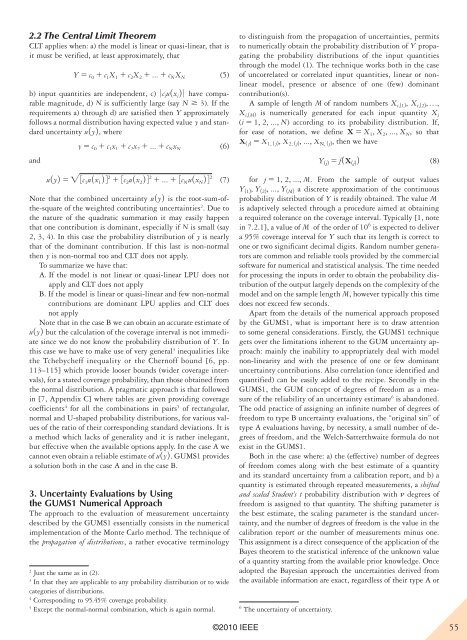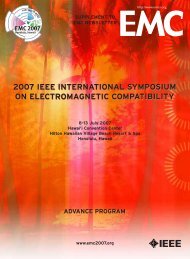Tutorial: EMC & Signal Integrity using SPICE, page 44 - IEEE EMC ...
Tutorial: EMC & Signal Integrity using SPICE, page 44 - IEEE EMC ...
Tutorial: EMC & Signal Integrity using SPICE, page 44 - IEEE EMC ...
You also want an ePaper? Increase the reach of your titles
YUMPU automatically turns print PDFs into web optimized ePapers that Google loves.
2.2 The Central Limit Theorem<br />
CLT applies when: a) the model is linear or quasi-linear, that is<br />
it must be verified, at least approximately, that<br />
Y 5 c 0 1 c 1X 1 1 c 2X 2 1 ... 1 c N X N (5)<br />
b) input quantities are independent, c) 0 c iu1x i 2 0 have comparable<br />
magnitude, d) N is sufficiently large (say N $ 3). If the<br />
requirements a) through d) are satisfied then Y approximately<br />
follows a normal distribution having expected value y and standard<br />
uncertainty u1y2, where<br />
and<br />
y 5 c 0 1 c 1x 1 1 c 2x 2 1 ... 1 c N x N (6)<br />
u1y2 5 "3c 1u1x 1 2 4 2 1 3c 2u1x 2 2 4 2 1 ... 1 3c N u1x N 2 4 2 (7)<br />
Note that the combined uncertainty u1y2 is the root-sum-ofthe-square<br />
of the weighted contributing uncertainties 2 . Due to<br />
the nature of the quadratic summation it may easily happen<br />
that one contribution is dominant, especially if N is small (say<br />
2, 3, 4). In this case the probability distribution of y is nearly<br />
that of the dominant contribution. If this last is non-normal<br />
then y is non-normal too and CLT does not apply.<br />
To summarize we have that:<br />
A. If the model is not linear or quasi-linear LPU does not<br />
apply and CLT does not apply<br />
B. If the model is linear or quasi-linear and few non-normal<br />
contributions are dominant LPU applies and CLT does<br />
not apply<br />
Note that in the case B we can obtain an accurate estimate of<br />
u1y2 but the calculation of the coverage interval is not immediate<br />
since we do not know the probability distribution of Y. In<br />
this case we have to make use of very general 3 inequalities like<br />
the Tchebycheff inequality or the Chernoff bound [6, pp.<br />
113–115] which provide looser bounds (wider coverage intervals),<br />
for a stated coverage probability, than those obtained from<br />
the normal distribution. A pragmatic approach is that followed<br />
in [7, Appendix C] where tables are given providing coverage<br />
coefficients 4 for all the combinations in pairs 5 of rectangular,<br />
normal and U-shaped probability distributions, for various values<br />
of the ratio of their corresponding standard deviations. It is<br />
a method which lacks of generality and it is rather inelegant,<br />
but effective when the available options apply. In the case A we<br />
cannot even obtain a reliable estimate of u1y2. GUMS1 provides<br />
a solution both in the case A and in the case B.<br />
3. Uncertainty evaluations by Using<br />
the GUMS1 Numerical Approach<br />
The approach to the evaluation of measurement uncertainty<br />
described by the GUMS1 essentially consists in the numerical<br />
implementation of the Monte Carlo method. The technique of<br />
the propagation of distributions, a rather evocative terminology<br />
2 Just the same as in (2).<br />
3 In that they are applicable to any probability distribution or to wide<br />
categories of distributions.<br />
4 Corresponding to 95.45% coverage probability.<br />
5 Except the normal-normal combination, which is again normal.<br />
©2010 <strong>IEEE</strong><br />
to distinguish from the propagation of uncertainties, permits<br />
to numerically obtain the probability distribution of Y propagating<br />
the probability distributions of the input quantities<br />
through the model (1). The technique works both in the case<br />
of uncorrelated or correlated input quantities, linear or nonlinear<br />
model, presence or absence of one (few) dominant<br />
contribution(s).<br />
A sample of length M of random numbers X i,112, X i,122, ...,<br />
X i,1M2 is numerically generated for each input quantity X i<br />
(i 5 1, 2, ..., N) according to its probability distribution. If,<br />
for ease of notation, we define X 5 X 1, X 2, ..., X N, so that<br />
X1 j2 5 X 1, 1 j2, X 2, 1j2, ..., X N, 1j2, then we have<br />
Y1j2 5 f1X1j22 (8)<br />
for j 5 1, 2, ..., M. From the sample of output values<br />
Y112, Y122, ..., Y1M2 a discrete approximation of the continuous<br />
probability distribution of Y is readily obtained. The value M<br />
is adaptively selected through a procedure aimed at obtaining<br />
a required tolerance on the coverage interval. Typically [1, note<br />
in 7.2.1], a value of M of the order of 10 6 is expected to deliver<br />
a 95% coverage interval for Y such that its length is correct to<br />
one or two significant decimal digits. Random number generators<br />
are common and reliable tools provided by the commercial<br />
software for numerical and statistical analysis. The time needed<br />
for processing the inputs in order to obtain the probability distribution<br />
of the output largely depends on the complexity of the<br />
model and on the sample length M, however typically this time<br />
does not exceed few seconds.<br />
Apart from the details of the numerical approach proposed<br />
by the GUMS1, what is important here is to draw attention<br />
to some general considerations. Firstly, the GUMS1 technique<br />
gets over the limitations inherent to the GUM uncertainty approach:<br />
mainly the inability to appropriately deal with model<br />
non-linearity and with the presence of one or few dominant<br />
uncertainty contributions. Also correlation (once identified and<br />
quantified) can be easily added to the recipe. Secondly in the<br />
GUMS1, the GUM concept of degrees of freedom as a measure<br />
of the reliability of an uncertainty estimate 6 is abandoned.<br />
The odd practice of assigning an infinite number of degrees of<br />
freedom to type B uncertainty evaluations, the “original sin” of<br />
type A evaluations having, by necessity, a small number of degrees<br />
of freedom, and the Welch-Satterthwaite formula do not<br />
exist in the GUMS1.<br />
Both in the case where: a) the (effective) number of degrees<br />
of freedom comes along with the best estimate of a quantity<br />
and its standard uncertainty from a calibration report, and b) a<br />
quantity is estimated through repeated measurements, a shifted<br />
and scaled Student’s t probability distribution with n degrees of<br />
freedom is assigned to that quantity. The shifting parameter is<br />
the best estimate, the scaling parameter is the standard uncertainty,<br />
and the number of degrees of freedom is the value in the<br />
calibration report or the number of measurements minus one.<br />
This assignment is a direct consequence of the application of the<br />
Bayes theorem to the statistical inference of the unknown value<br />
of a quantity starting from the available prior knowledge. Once<br />
adopted the Bayesian approach the uncertainties derived from<br />
the available information are exact, regardless of their type A or<br />
6 The uncertainty of uncertainty.<br />
55

















